30 Best Places to Visit in the United States

It’s your authoritative guide to the nation’s must-see destinations, helping you prioritize national parks and iconic cities from the Grand Canyon to New York City; use this list to plan routes, timing, and activities so you maximize scenery and culture. Expect breathtaking views, rich history, and vibrant local culture, but prepare for wildlife encounters and rugged trails in remote parks by packing proper gear and safety plans.
Key Takeaways:
- The U.S. offers vast geographic variety—national parks, coastlines, cities, deserts, and mountains.
- National parks are signature attractions: Grand Canyon, Yellowstone, Yosemite, Zion, Glacier, and Great Smoky Mountains.
- Iconic cities deliver museums, theaters, landmarks, dining, and nightlife—New York City, San Francisco, Las Vegas, Chicago, Boston, and Washington, D.C.
- Southern destinations combine historic charm, music, and regional cuisine—Savannah, Charleston, New Orleans, Nashville, and Austin.
- California coast and the Pacific Northwest pair beaches and urban culture with easy outdoor access—Los Angeles, San Diego, San Francisco, Seattle, and Portland.
- Mountain and desert towns are ideal for hiking, scenic drives, and wellness retreats—Asheville, Sedona, Santa Fe, and Denver.
- Coastal escapes and classic Americana round out the list: Miami/South Beach, Key West, Cape Cod, Vermont, plus the Route 66 road trip.
Must-See National Parks in the USA
1. Exploring Yellowstone National Park: A Natural Wonder
You can watch Old Faithful erupt roughly every 90 minutes and marvel at the Grand Prismatic Spring’s vivid bands of color; driving the 142‑mile Grand Loop connects geysers, hot springs, and the Grand Canyon of the Yellowstone.
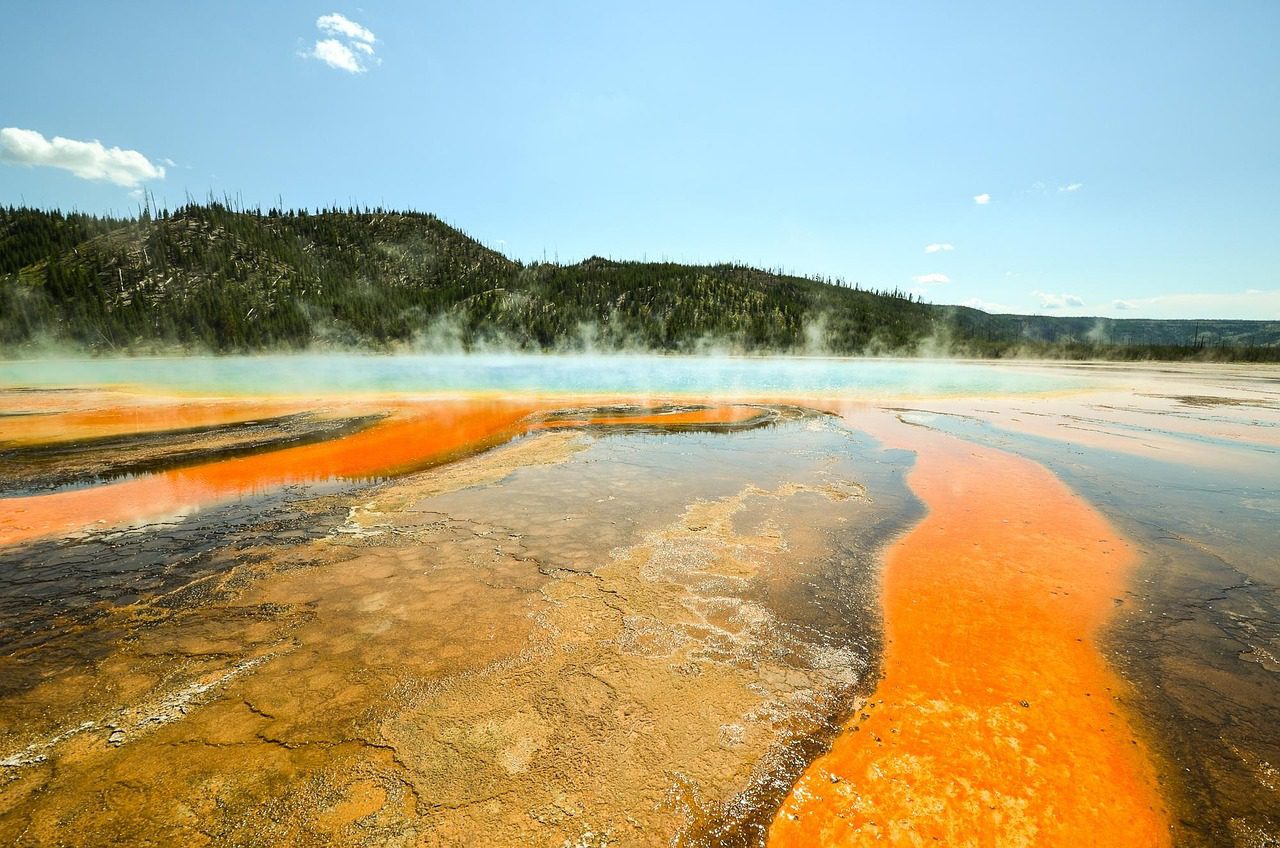
Hayden and Lamar Valleys offer reliable bison and elk sightings, plus wolf packs at dawn.
Stay on boardwalks and marked trails—thermal features are deadly if you stray—and book lodges early for peak season to secure your basecamp.
2. Hiking Trails in the Grand Canyon: A Breathtaking Experience
You can tackle corridor trails like Bright Angel and South Kaibab for dramatic rim views, or plan a rim‑to‑river backpack with a permit; the canyon drops nearly a mile, so your descent is easy and the return is grueling.
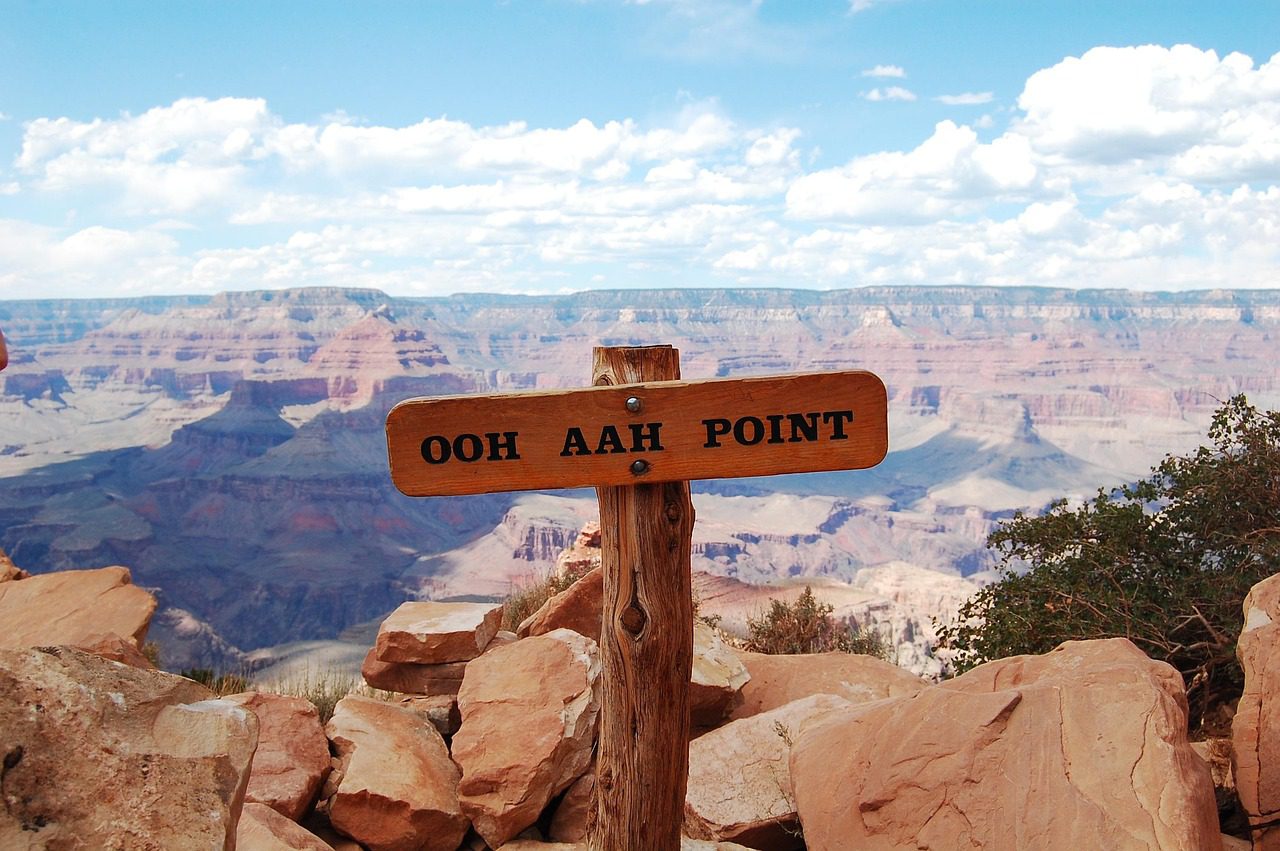
Carry ample water, start at cooler hours, and use shuttle services from Grand Canyon Village.
Dehydration and heat-related emergencies are the park’s biggest hazards, so pace yourself and know your limits.
Bright Angel offers shade, seasonal water stations, and switchbacks that ease elevation change, while South Kaibab delivers panoramic vistas with less shade—no water available.
Rim‑to‑river hikes involve roughly 4,000–5,000 feet of elevation change, so many hikers split the trip with an overnight river campsite (backcountry permits required).
Plan for summer temperatures over 100°F in the inner canyon, leave early, stash emergency electrolytes, and file a trip plan with park rangers before attempting long descents.
3. Discovering the Smoky Mountains: A Family Vacation Destination
You can drive the 11‑mile Cades Cove loop for wildlife viewing, stroll to Laurel Falls (about 2.6 miles round trip), and explore Appalachian history at preserved homesteads; with over 800 miles of trails, the park suits all ages.
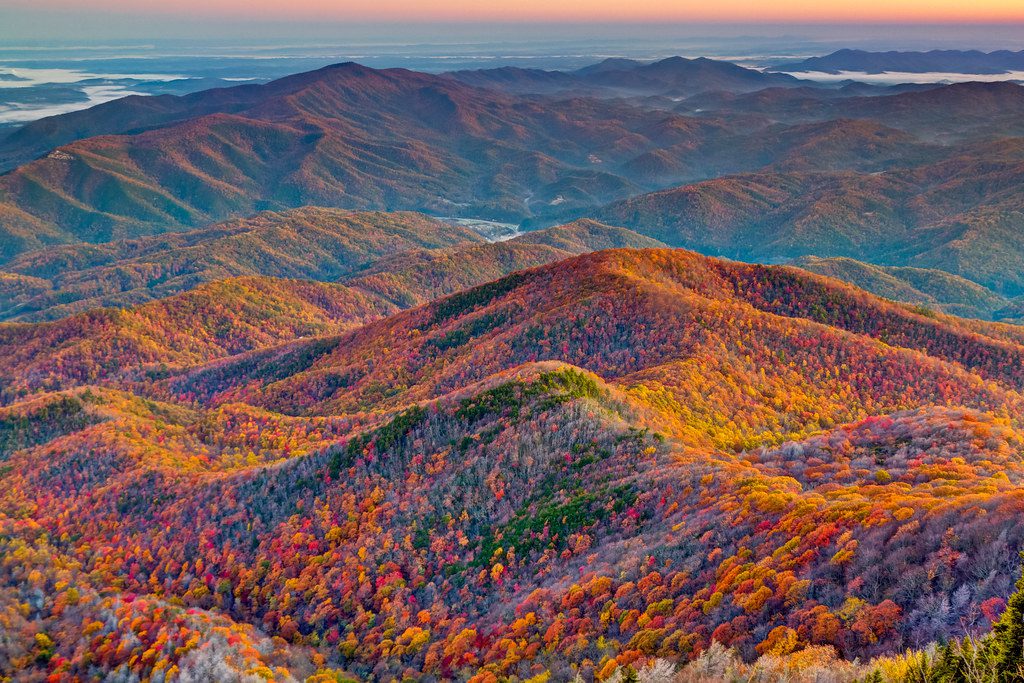
Peak fall color draws over 12 million visitors annually, so reserve campsites and parking ahead. Ranger programs and junior ranger activities make it ideal for families.
Clingmans Dome rises to 6,643 feet and offers a paved, steep half‑mile to an observation tower with sweeping views; several historic buildings in Cataloochee provide elk sightings and living‑history demonstrations.
Black bears roam the valleys—store food in provided lockers and keep at least 50 yards away if you encounter one.
Many trailheads have limited parking, so arrive early or use shuttle services where available.
4. Yosemite National Park: Iconic Landscapes and Waterfalls
You can stand at Tunnel View for classic views of El Capitan and Half Dome, watch Yosemite Falls tumble 2,425 feet, and wander Mariposa Grove among giant sequoias.
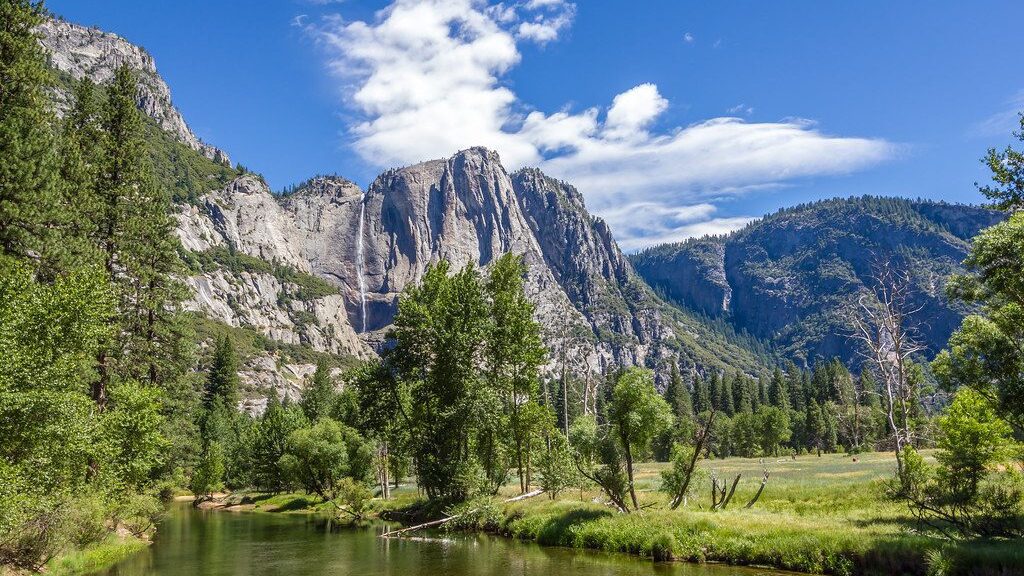
Half Dome requires a cable permit for the final ascent, while climbers tackle El Capitan’s ~3,000‑foot granite face. Book valley reservations in summer and prepare for congested parking.
Hike the Mist Trail to Vernal and Nevada Falls for close, thunderous cascades—expect wet, slippery granite in spring runoff and carry traction devices. Glacier Point and Taft Point deliver sunrise and sunset panoramas; Glacier Point Road has seasonal closures, so check conditions.
For ambitious routes like Half Dome or multi‑day climbs on El Capitan, secure permits well in advance and use certified guides if you’re inexperienced.
5. Zion National Park: Majestic Canyons and Trails
You can conquer Angels Landing for adrenaline‑packed ridgeline views (permit required), wade The Narrows through the Virgin River for a slot‑canyon adventure, or take the family on Canyon Overlook Trail for easy vistas.
Shuttle service reduces congestion in peak months.

Angels Landing’s exposed sections and Narrows’ flash‑flood risk are the park’s leading hazards, so check forecasts and permit rules.
Angels Landing is about a 5.4‑mile round trip with steep switchbacks and a chained final half‑mile where footing is narrow; dawn or late afternoon reduces heat stress.
The Narrows offers both day hikes (no permit) and the top‑down multi‑day route (permit required)—wading through cold water and slippery rocks; rent neoprene socks and a walking stick from Springdale outfitters.
Flash flood watches can close trails with little notice.
6. Glacier National Park: Untamed Wilderness and Wildlife
You can drive the 50‑mile Going‑to‑the‑Sun Road for jaw‑dropping alpine views, hike sections of over 700 miles of trails, and spot mountain goats, moose, and grizzly bears in alpine basins.
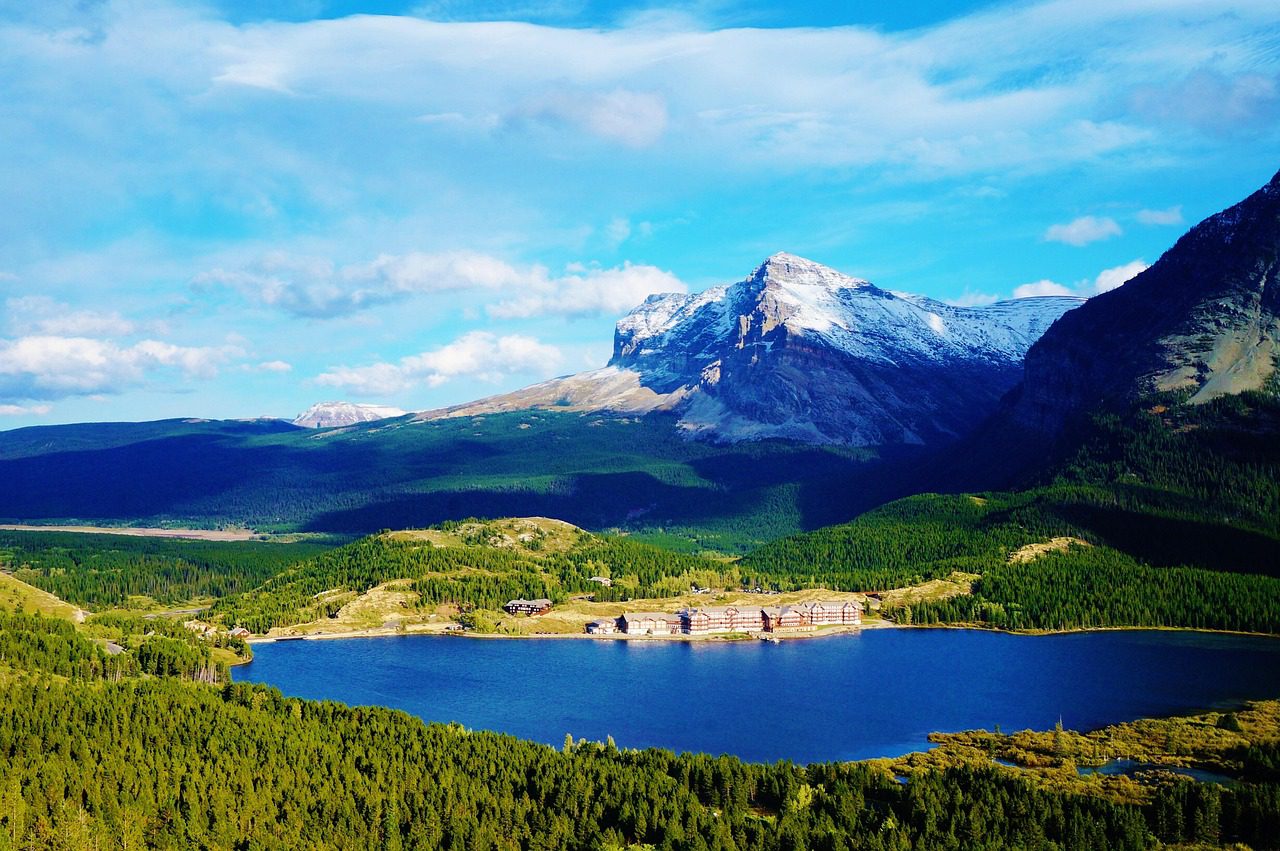
Weather shifts quickly at high elevation—carry layers and bear spray—and reserve lodging or backcountry permits early, as the park ranks among the nation’s top destinations.
Many Glacier and Two Medicine are prime spots for wildlife viewing and trailheads to alpine lakes; expect elevations above 7,000 feet on popular routes with late‑season snow.
Backcountry camping requires permits and campsite selection; carry a bear canister where mandated and practice group travel in bear country.
Road delays and seasonal openings on Going‑to‑the‑Sun mean flexible timing improves your chance to hit key overlooks without crowds.
Iconic Cities in the USA
Explore major urban highlights that pair cultural institutions with unforgettable experiences; consult Best Places to Visit in the USA for 2025 – U.S. News Travel for updated rankings and trip ideas.
You’ll move from skyline views to historic streets, spotting must-see landmarks, local food scenes, and practical travel notes that shape your itinerary.
7. New York City: The City That Never Sleeps
You can spend days between Broadway, the Met, and MoMA, and iconic sights like the Statue of Liberty and Empire State Building; Times Square draws about 50 million visitors yearly.
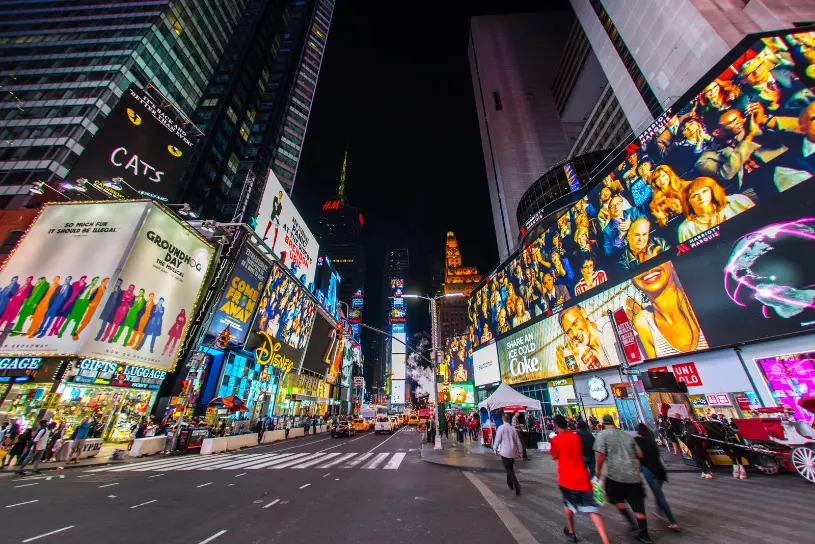
Walk Central Park, hop subway lines to diverse neighborhoods, and plan for heavy crowds—you’ll want reservations for top restaurants and timed-entry museums.
8. San Francisco: Golden Gate and Cultural Diversity
The Golden Gate Bridge spans about 1.7 miles, offering scenic walks and photo ops; you can tour Alcatraz from Pier 33, ride historic cable cars, and explore neighborhoods from Chinatown to the Mission for outstanding food.

Prepare for steep hills and variable microclimates that change block by block.
Fisherman’s Wharf and Pier 39 are tourist hubs where you can join bay cruises and see sea lions; tech centers lie roughly 30 miles south in Silicon Valley, making SF both a cultural and innovation gateway.
Expect high lodging costs and limited parking—use public transit and book ferries early.
9. Las Vegas: Entertainment Capital of the World
The Las Vegas Strip runs roughly 4.2 miles and stacks megaresorts with 24/7 casinos, headline shows, and celebrity-chef restaurants; you can drive less than an hour to Red Rock Canyon or take a 2.5–3 hour trip to the Grand Canyon.

Watch for extreme summer heat and late-night crowds.
Shows from Cirque du Soleil to residency concerts rotate constantly, and resort attractions—like the Venetian gondolas or Bellagio fountains—are free to view.
Manage your budget: gambling carries real financial risk, so set limits and consider daytime excursions to avoid nonstop high-stakes environments.
10. Chicago: Architectural Marvels and Deep Dish Pizza
You can ride the river architecture tour, visit the Art Institute of Chicago, and snap photos at Millennium Park’s Cloud Gate (“The Bean”).

Willis Tower’s Skydeck sits on the 103rd floor for panoramic views; indulge in deep-dish pizza, born at Pizzeria Uno in 1943, and stroll the Lakefront Trail.
Neighborhoods like Wicker Park and Lincoln Park offer craft breweries and music venues; public transit and bike-share make getting around easy.
Expect windy conditions along Lake Michigan and plan museum visits—the Art Institute and Field Museum often host major traveling exhibitions that sell out.
11. Boston: Rich History and Education Hub
The 2.5-mile Freedom Trail links 16 historic sites, including Paul Revere’s House and the Old North Church; Fenway Park opened in 1912 as MLB’s oldest ballpark.

Cross the Charles River to visit Harvard and MIT, sample North End Italian food, and explore Beacon Hill’s brick streets.
Boston’s compact layout means you can walk between major attractions; the MBTA “T” provides subway access, though service can vary on weekends.
Expect busy summers and fall college activity—you’ll likely log several miles on foot while discovering hidden historic plaques and local bakeries.
12. Washington, D.C.: The Heart of American Politics
The National Mall centers monuments like the Lincoln Memorial and Washington Monument and hosts 10 Smithsonian museums—many with free admission—so you can build a low-cost, high-value itinerary.

Peak times draw large crowds around cherry blossom season and major events.
Security around the White House and Capitol is tight, and parking is scarce—use Metro or bike-share to navigate efficiently.
Plan for longer waits at popular museums and note that many memorials are open 24 hours while museum hours vary seasonally; expect heightened security near government buildings.
Southern Charm & Culture
13. Savannah, Georgia: Historic Squares and Southern Hospitality
You can wander Savannah’s 22 historic squares, where moss-draped live oaks frame antebellum mansions and cobblestone streets; the Historic District leads to River Street’s shops and the First African Baptist Church, a site linked to Underground Railroad history.

Guided trolley or ghost tours give context while you sample Lowcountry flavors at local taverns, making Savannah a slow, picturesque escape with plenty of photo-worthy corners and lingering southern hospitality.
14. Charleston, South Carolina: Well-Preserved History and Charm
You’ll find well-preserved antebellum architecture, colorful row houses along Rainbow Row, and horse-drawn carriage tours that trace the Historic District to the Battery promenade; Lowcountry cuisine—think she-crab soup and shrimp and grits—anchors the city’s culinary scene.

Galleries, century-old churches, and waterfront parks keep Charleston intimate and walkable while maintaining deep historical resonance.
Founded in 1670, Charleston offers a layered history from colonial streets to Civil War sites such as Fort Sumter (ferry-accessible from Liberty Square); plantation tours at nearby properties showcase rice and indigo era landscapes alongside formal gardens.
You can dine at James Beard–nominated restaurants, book carriage rides that explain architectural periods, and factor in hurricane season (June–November) when planning—storms can affect ferry and tour schedules.
15. New Orleans, Louisiana: A Festival of Cultures and Flavors
You’ll experience the birthplace of jazz in the French Quarter and on Frenchmen Street, where brass bands and street performers define the nights; Creole and Cajun kitchens serve gumbo, jambalaya, and beignets at Café du Monde.

Annual highlights like Mardi Gras and countless neighborhood festivals turn the city into a nonstop celebration of music, food, and multicultural heritage.
Beyond Bourbon Street, the National WWII Museum and live-music venues preserve New Orleans’ cultural depth; you can catch intimate jazz sets, second-line parades, and pop-up brass bands in local parks.
Festival crowds swell during Mardi Gras and Jazz Fest, so plan logistics and be mindful of flooding and hurricane risk—insurance and flexible bookings help when storms threaten the Gulf Coast.
16. Nashville, Tennessee: Music City and Southern Hospitality
You can trace country music history from the Grand Ole Opry and Ryman Auditorium to the interactive exhibits at the Country Music Hall of Fame; honky-tonk bars on Broadway stream live acts day and night.
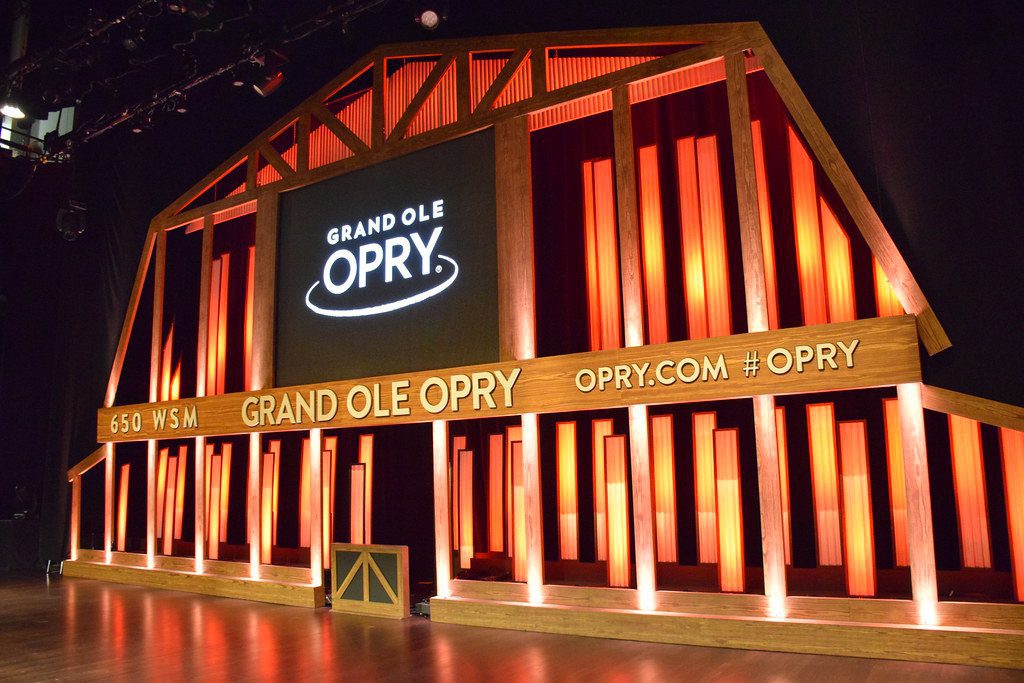
Hot chicken joints, burgeoning farm-to-table restaurants, and music-themed museums give you both classic and contemporary Nashville energy.
Music Row’s studios still produce chart-topping acts, while singer-songwriter open-mic nights and rooftop venues let you discover unsigned talent.
Plan to visit during CMA Fest if you want massive live-event energy; otherwise, midweek shows offer easier access.
Expect growing traffic in central neighborhoods as the city expands, and reserve popular venue tickets in advance.
17. Austin, Texas: Capital of Live Music and Cultural Innovation
You’ll find the “Live Music Capital of the World” alive with nightly performances across bars, coffeehouses, and parks; food trucks and legendary barbecue joints fuel late-night sets, while the Congress Avenue Bridge hosts a nightly bat exodus from spring through fall.
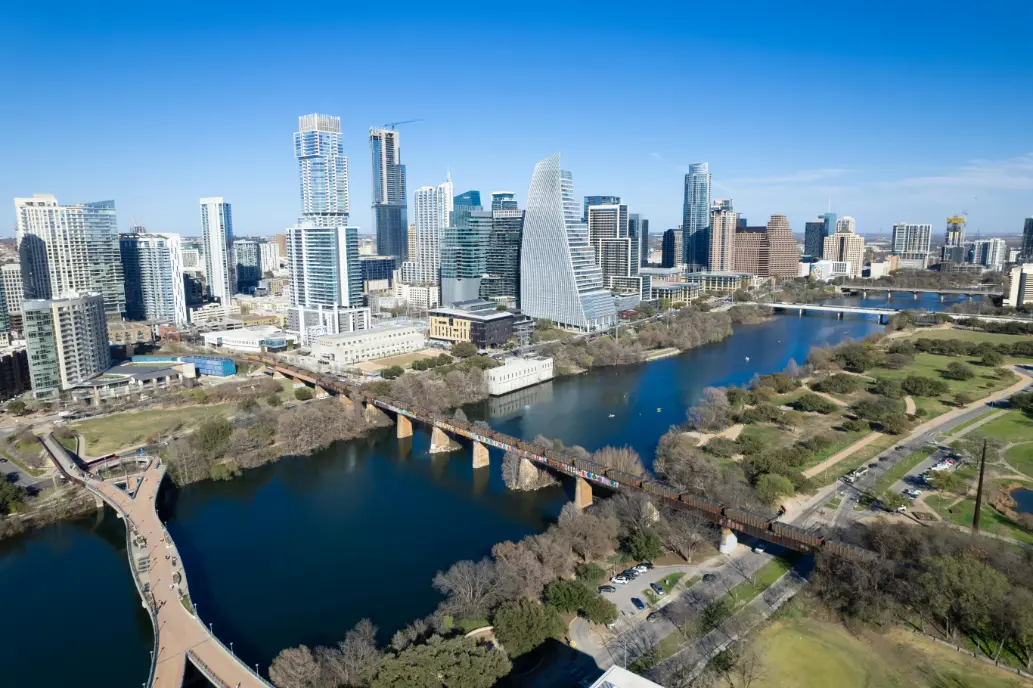
“Keep Austin Weird” remains visible in its quirky shops, murals, and DIY art scene.
Major events like SXSW (March) and Austin City Limits (October) bring global artists and industry panels; Barton Springs Pool offers a year-round 68–70°F swim as a downtown respite.
Hyphenate outdoor plans with sun protection and flexible scheduling—summer heat and flash flooding can disrupt shows and outdoor activities, so check local forecasts before heading out.
California Coast & Pacific Northwest
Span coastlines from sun-soaked Southern California to misty Pacific Northwest forests: you can follow Highway 1 for dramatic cliffs and seaside towns, then head north to temperate rainforests, volcanoes, and ferry crossings.
Expect diverse weather—sun and beach days in SoCal, frequent rain and snow in the mountains—and plan around wildfire season in late summer and heavy winter storms in the Northwest.
18. Los Angeles: The Entertainment Hub of the World
Explore Hollywood attractions like the Walk of Fame and Griffith Observatory, stroll Santa Monica Pier and Venice Beach, and tour studios or the Getty Center; you can drive about 25–35 miles to Disneyland in Anaheim.

Expect world-class dining across neighborhoods and heavy traffic—plan extra time and watch for seasonal wildfire smoke that can reduce air quality.
19. San Diego: Beautiful Beaches and Family Fun
Balboa Park’s museums and gardens, the world-famous San Diego Zoo, La Jolla’s coves, and Coronado’s beaches give you endless family-friendly options; the city averages near 70–75°F year-round, which is a major positive, but be mindful of rip currents at open beaches.

San Diego Zoo houses more than 3,700 animals across 650+ species in over 100 acres within Balboa Park; you can kayak La Jolla Cove to see sea lions, hike Torrey Pines State Reserve for coastal cliffs, and take whale-watching cruises during the grey whale migration (December–April).
Nightlife in the Gaslamp Quarter, the USS Midway Museum, and a booming craft beer and Mexican-food scene make the city ideal for families and food-focused travelers; Tijuana is roughly 20 miles south for day-trip border culture.
20. Seattle: The Emerald City and Coffee Capital
Pike Place Market’s lively stalls and the original Starbucks (1971) meet the 605‑foot Space Needle and waterfront ferries; you’ll appreciate a strong coffee scene and quick access to Mount Rainier (about 90 miles southeast) and Olympic National Park, but prepare for frequent rain and steep, slick hills.
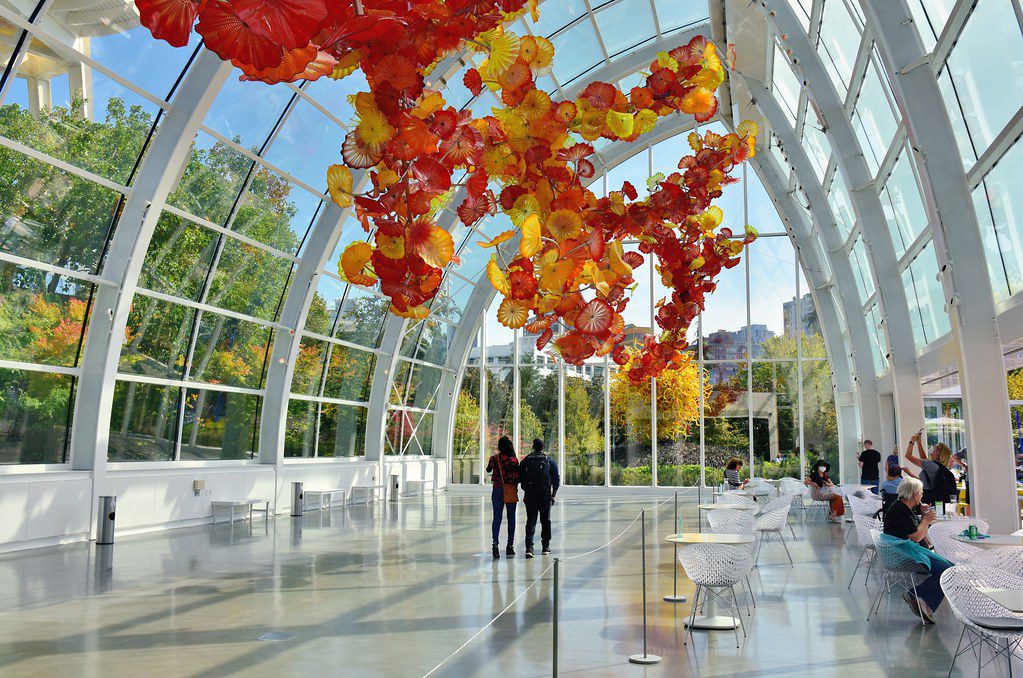
Capitol Hill’s nightlife, MoPOP, and Chihuly Garden & Glass offer cultural depth; ferries to Bainbridge take about 35 minutes, turning the harbor into a daily commuter and sightseeing loop. Seafood is exceptional—fresh salmon and oysters—and tech companies like Amazon shape the downtown energy.
Mount Rainier (14,410 ft) dominates views and backcountry access; plan for wet weather gear and flexible itineraries during the rainy season.
21. Portland, Oregon: Quirky Charm and Natural Beauty
Tap into a legendary food-truck scene, over 70 craft breweries, and Powell’s bookstore while using Portland as a base for Columbia River Gorge hikes and the Oregon Coast; winters are wet, so bring layers and waterproofs for waterfall jaunts like Multnomah Falls (about 620 ft).

Powell’s City of Books spans a city block with over one million books, Washington Park hosts the Japanese Garden and International Rose Test Garden, and Voodoo Doughnut fuels late-night cravings.
Day trips take you to Mount Hood (roughly 90 minutes, elevation 11,239 ft) for skiing and to the Gorge for windsurfing at Hood River; cycling and public transit make getting around the city easy.
Mountain & Desert Destinations
22. Asheville, North Carolina: Arts and Outdoor Adventures
Set amid the Blue Ridge, Asheville gives you direct access to the 469-mile Blue Ridge Parkway, the 8,000-acre Biltmore Estate, and more than 30 craft breweries that earned the city repeated Beer City honors.
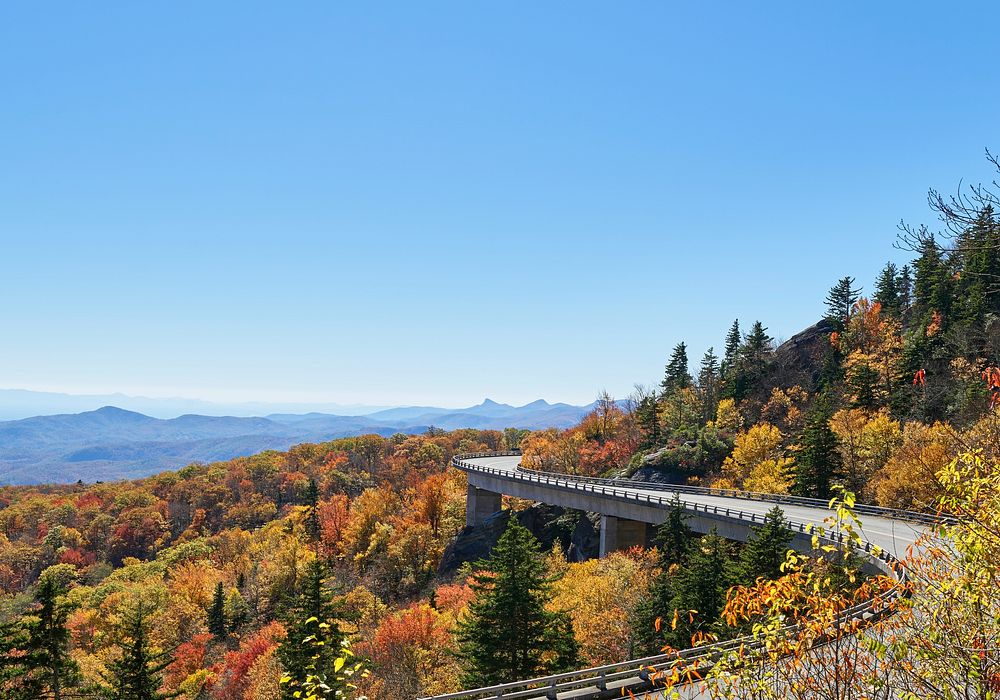
You can hike sections of the Appalachian Trail or drive to Mount Mitchell (6,683 ft) for sweeping views; plan carefully for steep, winding roads in winter if you visit during cold months.
23. : Spiritual Retreats and Natural Beauty
Famous red sandstone formations like Cathedral Rock and Bell Rock put Sedona on your must-see list, about 115 miles north of Phoenix.
You can join Jeep tours, book wellness retreats tied to reputed vortex sites, and hike the Oak Creek Canyon trails. Be aware of flash flooding during the monsoon season (July–August), when canyon washes become hazardous.

Elevation around 4,350 ft moderates summer heat and enhances stargazing. Sedona hosts the Sedona International Film Festival each February and offers off-road routes, such as Broken Arrow, for dramatic vistas.
You can tackle short-but-steep climbs (Cathedral Rock) or longer outings on the West Fork Trail; reserve guided tours for safety and local geology/Native cultural context.
24. Santa Fe, New Mexico: Art, History, and Southwestern Culture
At roughly 7,199 ft, Santa Fe blends adobe architecture, Canyon Road’s 100+ galleries, the Georgia O’Keeffe Museum, and the Loretto Chapel into a compact cultural core.
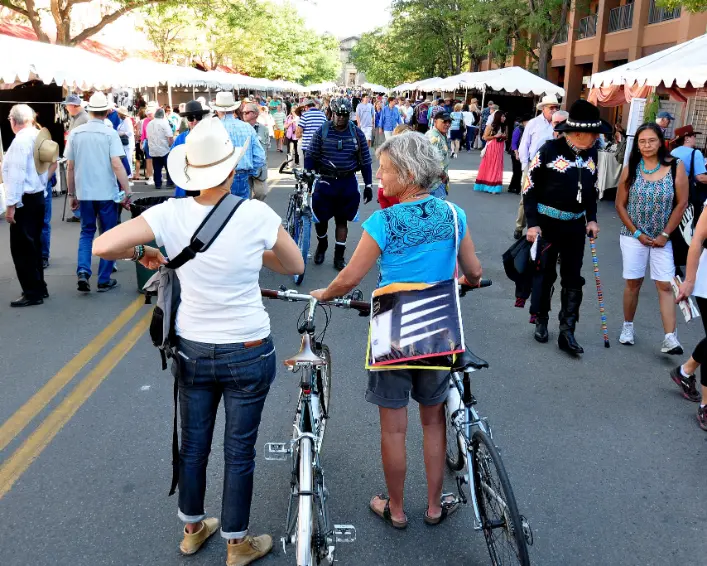
You can savor New Mexican cuisine centered on red and green chile, wander the historic Plaza, and attend seasonal markets; expect altitude-related effects if you arrive from lower elevations.
Santa Fe Indian Market draws tens of thousands annually, offering authentic Native art and performances; you can catch the summer Santa Fe Opera under the stars or take short drives to Taos Pueblo and Bandelier for archaeology and hiking.
Ski Santa Fe sits within a half-hour drive, giving you year-round mountain access alongside a rich calendar of festivals.
25. Denver, Colorado: Gateway to the Rockies
Denver sits at exactly 5,280 ft (one mile) above sea level, positioning you a short drive from world-class ski areas and Rocky Mountain National Park.
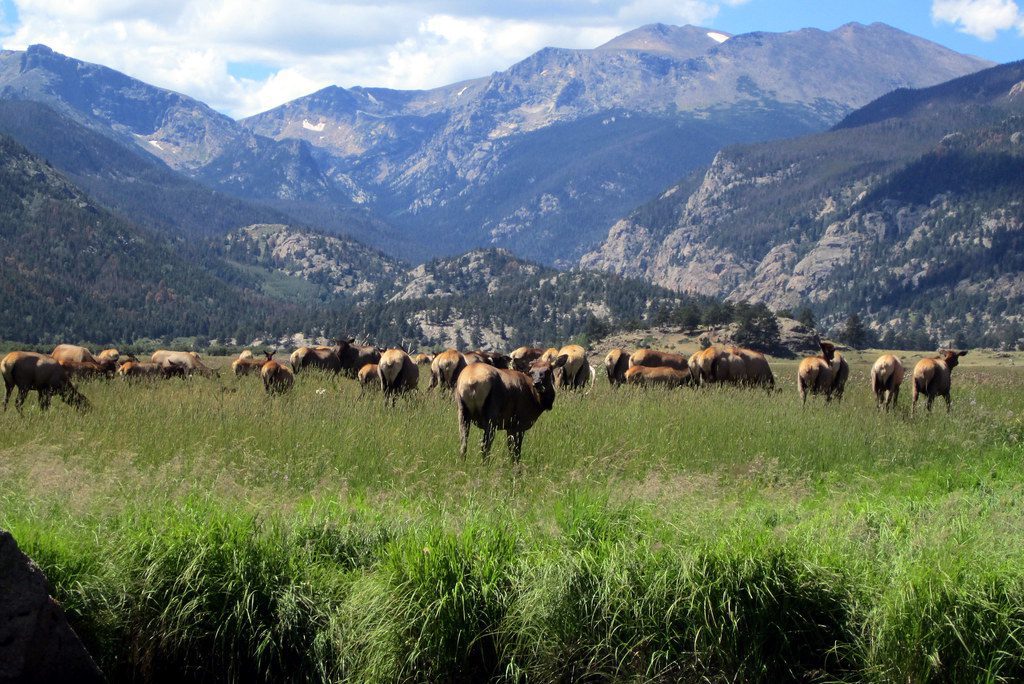
The city boasts more than 150 breweries, the iconic Red Rocks Amphitheatre, and museums like the Denver Art Museum; pack for altitude effects and rapidly changing mountain weather on day trips.
Denver International Airport (DIA) connects you to ski towns—Breckenridge and Keystone are roughly 1.5–2 hours away—while Rocky Mountain National Park lies about 70 miles northwest, with Trail Ridge Road opening seasonally above 12,000 ft.
Use acclimation time to avoid altitude sickness and check road conditions for snow closures when you plan mountain excursions.
Florida & Coastal Destinations
Along Florida’s coastline, you’ll find contrasts from Art Deco city beaches to remote island keys; visit barrier islands with shell beaches, the Everglades’ sawgrass marshes, and the Florida Keys coral reef—the only living barrier reef in the continental U.S.
Expect sun and warm water for most of the year, but plan around hurricane season (June–November) and stronger currents at exposed beaches when scheduling activities.
26. Miami/South Beach: Vibrant Nightlife and Beaches

You can stroll the Art Deco Historic District (over 800 buildings), shop on Lincoln Road, and sun on wide white sand before entering Ocean Drive’s restaurant scene and late-night clubs like LIV or smaller local venues on Española Way.
South Beach mixes people-watching, international dining, and galleries; traffic and crowds peak during Art Basel and winter high season, so book hotels and reservations well in advance.
27. Key West, Florida: Tropical Paradise and Chill Vibes
You’ll find the southernmost point (about 90 miles to Cuba), the Ernest Hemingway Home & Museum, and nightly celebrations at Mallory Square sunsets, with Duval Street’s bars and seafood shacks within walking distance.

Expect snorkel and dive trips to nearby reefs, a relaxed pace, and small-town island logistics that favor early bookings for ferries and tours.
Drive the Overseas Highway over 42 bridges on your way in, or fly into Key West International; the route includes the iconic Seven Mile Bridge and scenic ocean spans.
For day trips, a boat or seaplane to Dry Tortugas National Park (~70 miles west) rewards you with Fort Jefferson, pristine snorkeling, and fewer crowds.
Keep sunscreen and a lightweight rain jacket handy during hurricane season, and reserve reef tours and Hemingway House tickets ahead of peak winter dates.
New England Gems
You’ll find compact variety across New England’s coastlines and mountains, from lighthouses and cranberry bogs on Cape Cod to explosive fall foliage and maple farms in Vermont; plan for peak seasons and local ferries.
Use resources like USA Bucket List: 50 Unmissable Vacation Spots to time visits and compare itineraries, and expect seasonal crowds at popular towns and trails.
28. Cape Cod, Massachusetts: Scenic Shorelines and Whales
You can stroll dunes and boardwalks in Provincetown, visit historic lighthouses, and launch whale-watching tours from Barnstable Harbor; summer brings busy beaches and ferry service to Martha’s Vineyard.
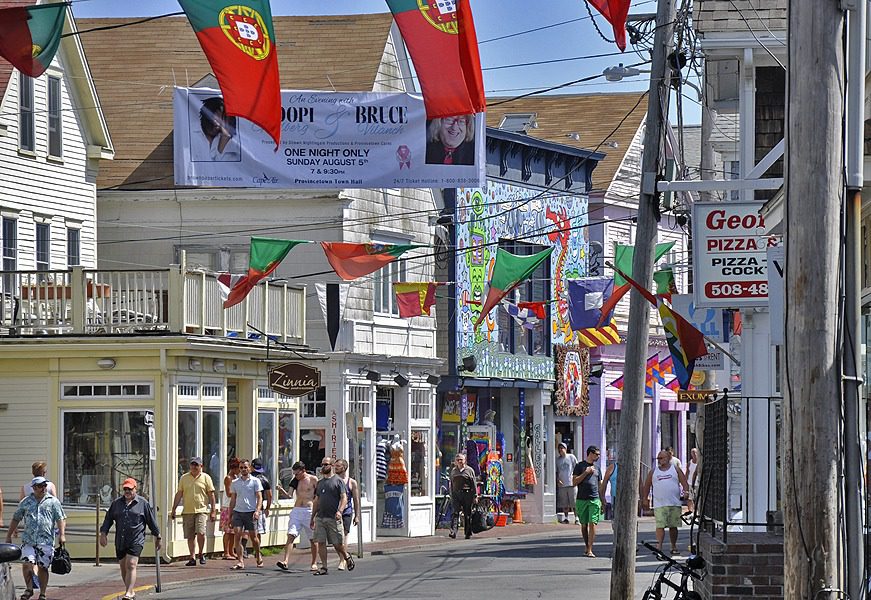
Watch for strong rip currents when swimming and plan parking or shuttle options during July–August to avoid long waits.
29. Vermont (Stowe/Burlington): Fall Foliage and Outdoor Sports
You’ll chase crimson and gold along Rt. 100, pedal Burlington’s lakeside bike paths, and hit Stowe’s slopes for alpine skiing; sample maple syrup at working farms and cross covered bridges for classic New England photos.
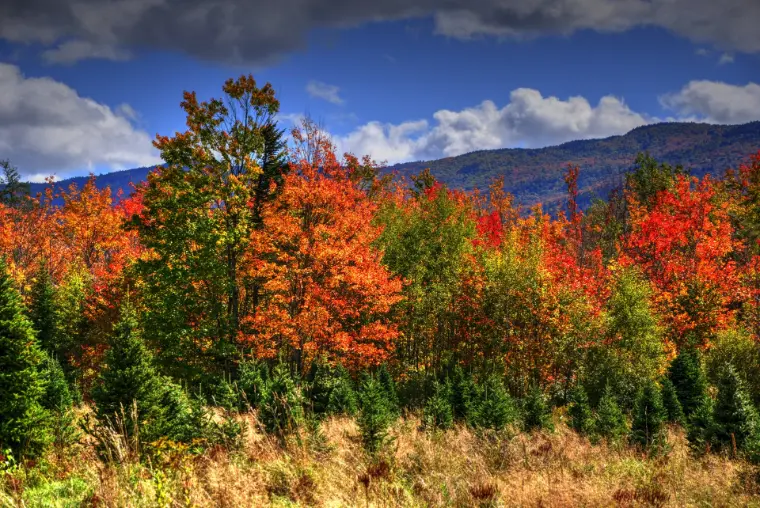
Be mindful of icy mountain roads in winter and book lodging early for peak foliage weekends.
Vermont centers around Lake Champlain’s waterfront in Burlington—you can explore the Church Street Marketplace, catch sunsets at Battery Park, or take a short drive to the Ben & Jerry’s factory in Waterbury for a tour.
Stowe sits beneath Mount Mansfield (the highest peak at 4,393 ft) with a mix of lift-served terrain, nearly 100 kilometers of Nordic trails, and extensive mountain-biking in summer.
Expect narrow, winding roads into alpine villages; plan winter tire chains or 4WD and check avalanche advisories if you venture into backcountry zones.
Unique American Experiences
30. Route 66: The Historic Highway Adventure
You can drive the original Route 66 corridor covering about 2,448 miles from Chicago to Santa Monica, stopping at neon motels, the Cadillac Ranch in Amarillo, and Petrified Forest National Park.

Travel popular segments across Illinois, Oklahoma, New Mexico, and Arizona. Prepare for long rural stretches with limited services; carry water, fuel, and a paper map for remote sections.
National Historic Trails: Paths of Significance
Follow America’s National Historic Trails like the Lewis and Clark Trail (about 4,900 miles), the Oregon Trail (~2,170 miles), and the Mormon Pioneer Trail (~1,300 miles).
You can visit trail markers, interpretive centers, and landmarks such as Chimney Rock and Register Cliff. Many segments are drivable or hikeable; consult National Park Service guides for seasonal access and permit details.
You can explore specific sites like the National Frontier Trails Museum in Independence, Missouri, Lewis and Clark centers at Great Falls and Fort Mandan, and preserved wagon ruts at Big Hole.
Ranger-led programs, GPS driving routes, and downloadable brochures let you plan day trips or multiweek treks. Aim for spring or fall to avoid summer heat and muddy backroads for safety.
Best Time to Visit
Seasonal Attractions: Planning Your Visit
Spring (Apr–May) and fall (Sep–Oct) offer the best balance: you can see Grand Canyon sunrises without summer crowds, catch New England peak foliage, and visit Glacier National Park as Going-to-the-Sun Road reopens. Summer (Jun–Aug) is ideal for high-elevation hiking and national park access, but brings the largest crowds.
Winter suits ski resorts—Denver, Vermont, Park City—while desert destinations like Sedona and Phoenix are far more pleasant in spring or late fall.
Weather Considerations Across Regions
The Southwest faces triple-digit heat in summer—Phoenix often tops 100°F—and a July–September monsoon with flash-flood risk; Florida’s hurricane season runs June–November with peaks in Aug–Sep; Pacific Northwest sees wet winters and milder summers; New England and the Rockies reward you with crisp fall and snowy winters respectively, with avalanche and road-closure concerns at higher elevations.
Plan around closures: Going-to-the-Sun Road typically opens late June, Yellowstone roads can close in winter, and high-country passes in the Rockies may get shut by snow from November to April.
Pack layers for temp swings, carry a weather app for real-time alerts, and factor in avalanche and flash-flood warnings when hiking slot canyons or backcountry routes.
Festivals and Events in Top Destinations
Mardi Gras in New Orleans (late Feb/Mar), Coachella in Indio (April; ~250,000 across two weekends), SXSW in Austin (March), and Sundance in Park City (January) consistently reshape local crowds and prices.
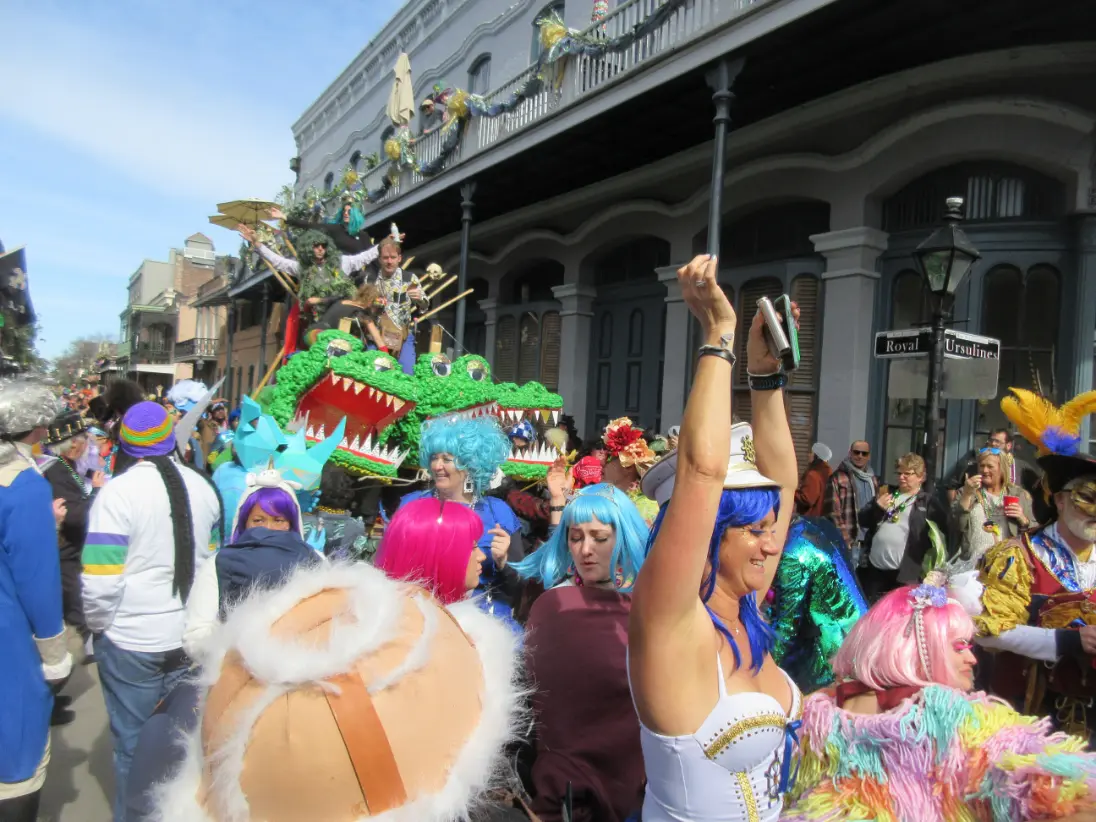
Major city events—Times Square New Year’s, Macy’s Thanksgiving Parade—draw tens to hundreds of thousands.
Book attractions and transit around these dates to avoid sold-out hotels and long lines.
Expect hotel rates and rideshare surge pricing; reserve lodging 3–6 months ahead for big festivals and secure event tickets early.
Arrive early to avoid transport delays, use official shuttles when offered, and keep copies of tickets and IDs.
High-attendance events can mean tight security lines and street closures, so plan extra time for entry and exits.
Culinary Adventures
Follow your appetite from New Orleans gumbo to San Francisco sourdough and Portland food trucks; you can taste the country’s variety bite by bite.
Seek out seafood fresh off docks in Maine, smokehouse barbecue in Texas, and coastal ceviche in San Diego. For more regional picks and itineraries, consult 31 Best Places to Visit in the USA (Updated 2025).
Exploring Regional Cuisines: A Tasty Tour
In the South, you’ll find Lowcountry shrimp and grits and Louisiana’s boudin; New England serves fresh lobster and clam chowder, while the Pacific Northwest highlights wild salmon and foraged mushrooms.
Head to Austin for brisket joints, to Portland for over 600 food carts, and to Santa Fe for New Mexican chiles—each region offers signature dishes tied to local history and ingredients you can’t replicate elsewhere.
Food Festivals: Savoring Local Flavors
You’ll experience culture through events like New Orleans Jazz & Heritage, Taste of Chicago, and the Maine Lobster Festival; expect large crowds, long lines, and rare local vendors.
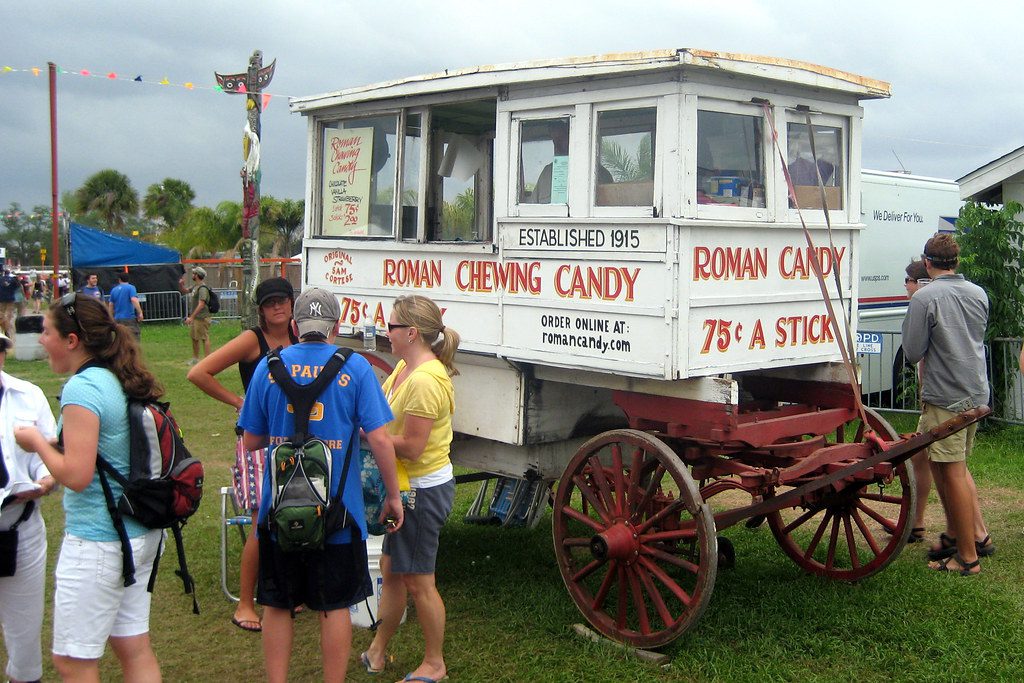
Festivals often run over a weekend, spotlighting hundreds of vendors and chef demos so you can sample dozens of dishes in one visit.
Plan festivals by month: New Orleans Jazz Fest usually lands in April–May, Taste of Chicago in July, and the Maine Lobster Festival in August.
Buy tickets or reserve seating early, arrive midday to avoid peak lines, and prioritize signature stalls—you’ll maximize tasting time if you map vendors before you go and share plates to try more specialties.
Best Restaurants in Must-Visit Cities
When you want a standout meal, reserve at flagship restaurants: think tasting menus in New York, San Francisco, and Chicago, acclaimed seafood in Boston, and inventive farm-to-table spots in Sonoma.
Expect higher prices at top tables but also memorable, chef-driven experiences that reflect local produce and techniques.
Specific options to consider: Eleven Madison Park and Le Bernardin in New York, Alinea in Chicago, The French Laundry in Napa Valley, and Benu in San Francisco—many require reservations weeks to months ahead.
Tasting menus commonly run from $150–$350+; you should check cancellation policies and dress codes before booking to avoid surprises.
Outdoor Activities and Adventure
National Park Adventures: Hiking, Camping & More
You can tackle the Grand Canyon’s Bright Angel Trail, ascend Angels Landing (permit required), or explore Glacier’s over 700 miles of trails and Yosemite’s Half Dome climb.
Backcountry camping often requires permits and careful route planning; expect close-up wildlife encounters with bison, bears, or elk and seasonal hazards like extreme heat or high altitude.
Carry maps, water, and reservations—campgrounds book months ahead.
Water Sports: From Coastlines to Lakes
You’ll find world-class surf at Huntington Beach and Oahu’s North Shore, snorkel reefs at Key Largo’s John Pennekamp State Park, and calm paddleboarding on Lake Tahoe (surface elevation 6,225 ft).
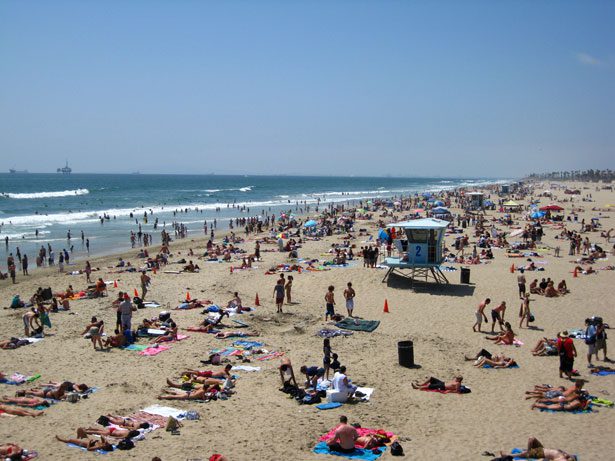
Kayak Acadia’s rocky coast to spot seals, or sail the five Great Lakes for long-distance cruising. Watch for rip currents and cold-water hypothermia; local lessons and rentals are widely available.
Check local tide charts, hire guides for surf breaks with strong currents, and obey boating rules—many states require a life jacket for children and mandate carriage on vessels.
In cold regions, wear a wetsuit; in coral areas, use reef-friendly sunscreen. Book snorkel and kayak trips in peak season (June–August), since operators in Key Largo and Acadia sell out quickly.
Skiing and Snowboarding Destinations
You can choose Vail or Aspen in Colorado, Park City (2002 Olympic host), or Jackson Hole with its 4,000+ ft vertical for expert runs.
Ski season generally runs from November–April, with snowmaking extending conditions at lower elevations. Expect busy lift lines during holiday weeks—buy lift tickets early or use Epic/Ikon passes for multi-resort access.
Be prepared for avalanches and altitude sickness on high-elevation terrain.
Backcountry outings require an avalanche beacon, probe, and shovel plus formal training—opt for guided tours or heli-ski operations in Alaska and the Tetons for big verticals and fresh powder.
Family resorts like Breckenridge and Stowe provide ski schools and nursery slopes; rental shops supply helmets and transceivers. Always check avalanche forecasts and weather before you head out.
Family-Friendly Destinations
Across the U.S., you can build family itineraries that balance thrills, learning, and outdoor time: Orlando’s resorts cluster theme parks and water parks, San Diego mixes beaches with Balboa Park museums, and national parks offer ranger programs for kids.
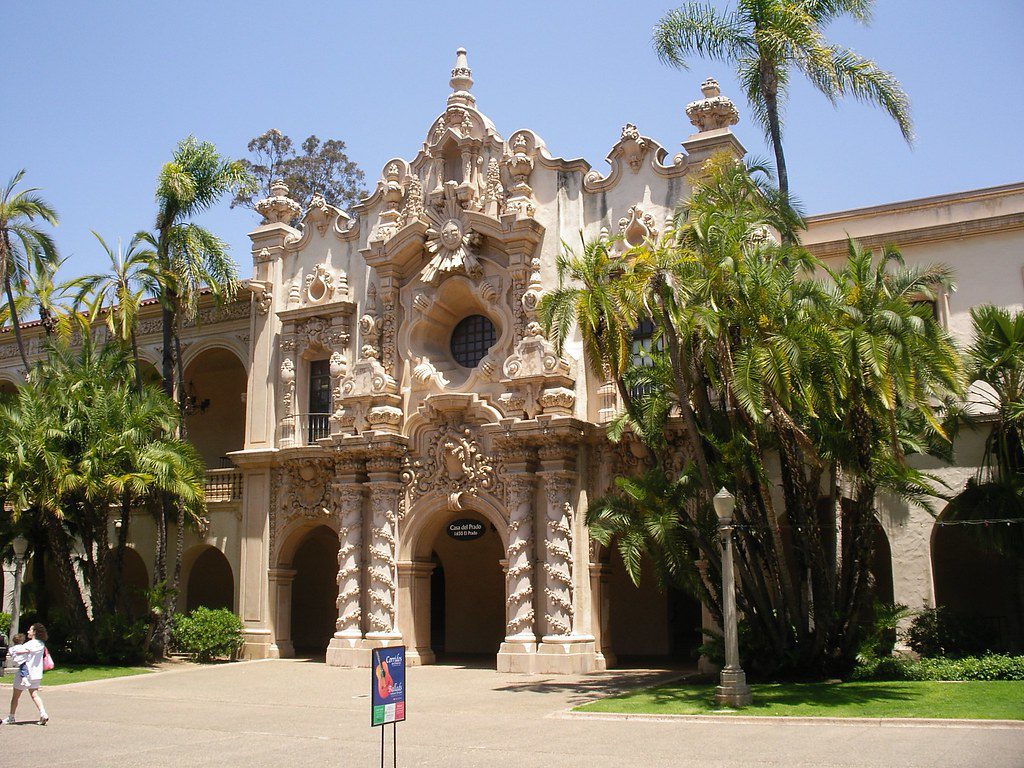
Book timed-entry passes and look for hotels with suites or kitchenettes.
Prioritize attractions with stroller access and family facilities, and plan downtime between high-energy activities; keeping naps and snack routines intact makes days smoother for both kids and adults.
Theme Parks: Magical Experiences for All Ages
You’ll find headline parks—Walt Disney World (four parks, two water parks), Disneyland Resort, Universal Orlando—and regionals like Cedar Point and Hersheypark offering family rides plus adrenaline coasters.
Expect long queues on peak days; plan Lightning Lane/Genie+, single-rider lines, or early entry. Watch ride height restrictions and wait times, and schedule midday breaks.
Character meet-and-greets, parades, and themed dining provide every-age magic, while resorts often bundle childcare and kid-friendly pools.
Museums for Kids: Educational Fun
Interactive museums engage kids with hands-on exhibits: the Children’s Museum of Indianapolis (the world’s largest) has Dinosphere displays, the American Museum of Natural History in NYC showcases dinosaur halls and a planetarium, and many Smithsonian museums in D.C. offer free admission.
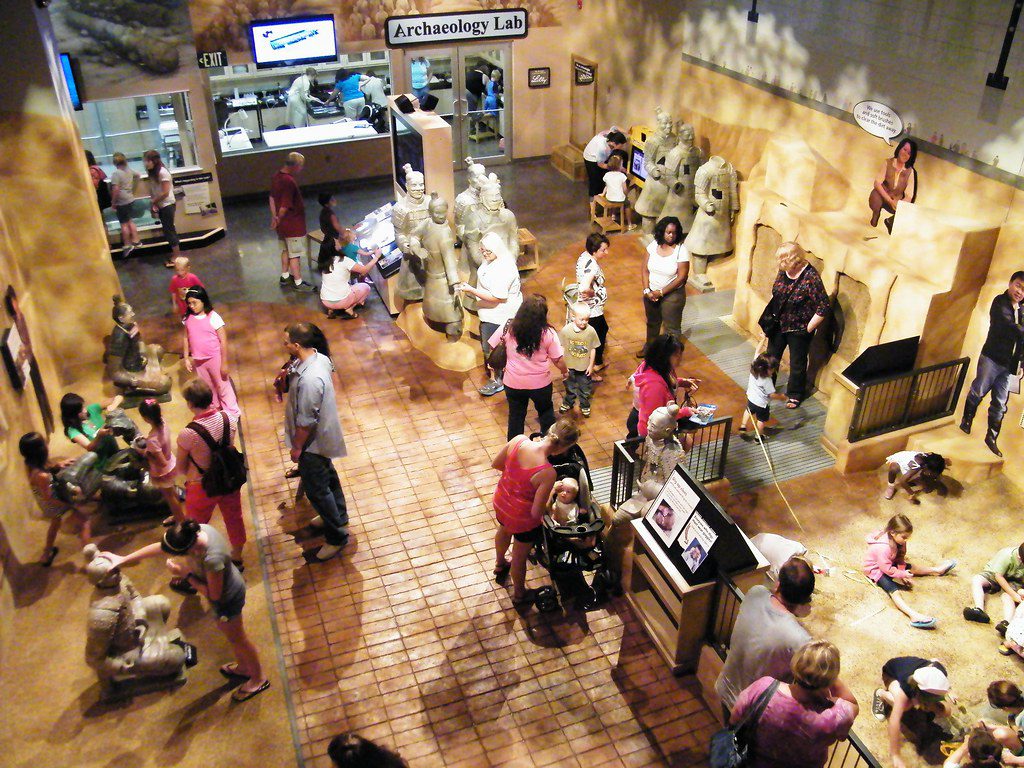
Look for touch tanks, maker labs, and science demos that turn learning into play; check exhibit age recommendations and supervised play areas to keep fragile artifacts safe.
Reserve timed-entry tickets for busy museums and use sensory-friendly hours if available; most family visits run 1–3 hours, depending on exhibit density.
Pack a small kit (wipes, snacks, change of clothes) and scout family amenities like nursing rooms, lockers, and stroller parking.
Seek docent-led activities and kids’ scavenger hunts—themed trails and planetarium shows often provide concentrated, memorable learning moments without museum fatigue.
Nature Trails and Parks Suitable for Families
Pick parks with short, scenic trails and easy access: Great Smoky Mountains (the most visited national park) offers Laurel Falls (about 2.6 miles round-trip) and stroller-friendly Cades Cove loop; Yosemite Valley has flat Valley Floor trails past Lower Yosemite Fall; Yellowstone’s boardwalks around Old Faithful let you view geothermal features safely.
Watch for wildlife—keep at least 25 yards away from large animals—and choose trails with minimal elevation gain for younger hikers.
Limit family hikes to under 3 miles or under 500 feet of elevation gain for elementary-age kids, and carry plenty of water, sunscreen, and layered clothing.
Enroll your kids in the Junior Ranger program at many national parks for structured learning and incentives.
In bear country, use park-provided food storage, avoid leaving snacks unattended, and check current trail conditions and closures before you head out.
Tips for Travelers
- Plan ahead
- Timing and seasons
- Budgeting for fees
- Safety practices
Match your itinerary to peak and shoulder seasons—Glacier sees heavy summer crowds while coastal towns calm down in fall—and prebook permits for hikes like Angels Landing or Alcatraz tours to avoid sold-out days.
Check weather alerts for hurricanes in Florida or snow closures in the Rockies, and carry a copy of your reservations and emergency contacts. This helps you avoid surprises and focus on the experience.
Essential Packing List for Various Destinations
Pack a modular system: layers (base, fleece, waterproof) for mountains, sturdy hiking boots for trails like Going-to-the-Sun Road, lightweight clothing, and reef-safe SPF 30+ sunscreen for beaches, and a compact umbrella for unpredictable East Coast weather.

Add a portable charger, printed IDs, and copies of reservations; store prescription meds and travel insurance info in your daypack so you can handle delays or sudden plan changes.
Transportation Options: Getting Around
Rent a car for flexibility on long routes—Route 66 and national park loops often require driving, while Amtrak’s California Zephyr and Coast Starlight offer scenic rail between major corridors; budget carriers slash coast-to-coast fares if you book 6–8 weeks out.
In cities, use public transit, rideshares, or bike-share systems to avoid parking fees and congestion.
When choosing a car rental, compare total costs including taxes, tolls, and parking: parking in Manhattan can exceed $60/day, while many national park lot fees run $20–35.
For train travel, reserve sleeper or seat classes early on popular routes and download offline maps for route changes; for flights, allow 90–120 minutes for domestic connections and factor in checked-bag fees to the final ticket price.
Safety Tips for Travelers in the USA
- Emergency numbers (dial 911)
- Wildlife protocols (stay 100 yards from bears)
- High-crime areas awareness
- Traffic rules and seat belts
Keep digital and paper copies of your ID and itinerary, lock valuables in hotel safes, avoid isolated areas at night, and follow posted guidance in parks about wildlife distances and food storage.
Carry a small first-aid kit and know the location of the nearest urgent care.
The U.S. healthcare system can be costly without coverage, so confirm your insurance or purchase travel medical protection.
- Local laws and ordinances
- Weather warnings and evacuation routes
- Transport safety (seat belts, helmets)
- Personal situational awareness
Check local police non-emergency numbers and use official apps for park alerts and city transit updates; in bear country, carry bear spray and know how to use it, and in hurricane zones, note nearest shelters and storm surge maps.
Keep emergency contacts accessible and share your plan with someone at home.
The proactive steps you take before departure reduce risk and speed recovery if incidents occur.
Final Thoughts
Plan spring (Apr–May) or fall (Sep–Oct) for milder crowds and weather; Glacier, ranked top for 2025, offers >700 miles of trails, while the South Rim of the Grand Canyon sits about 4.5 hours from Las Vegas.
If you want reliable geysers, Old Faithful erupts roughly every 90 minutes; wildlife watchers head to Hayden and Lamar Valleys for bison and wolves.
Expect heavy foot traffic at Times Square (50 million visitors annually) and respect steep hikes like Half Dome and Angels Landing (permit required) for safety.
FAQs: 30 best places to visit in the United States
What are the 30 best places to visit in the United States?
The 30 best places to visit in the United States include iconic destinations like the Grand Canyon, Yellowstone National Park, and Walt Disney World.
Other notable mentions are the Statue of Liberty, Alcatraz Island, and Central Park.
These locations offer breathtaking views, rich history, and fun activities for visitors.
What is the best time to visit the Grand Canyon?
The best time to visit the Grand Canyon is during the spring and fall months when the weather is mild, and the crowds are smaller.
Summer can be extremely hot, while winter may bring snow, but all seasons offer unique experiences and views.
Are there any family-friendly vacation spots in the USA?
Yes, many family-friendly vacation spots in the USA include theme parks like Walt Disney World in Orlando, the Smithsonian museums in Washington D.C., and national parks such as Yellowstone and the Great Smoky Mountains, which provide plenty of outdoor activities and educational experiences.
What are some must-see attractions in New York City?
Some must-see attractions in New York City include the Statue of Liberty, Central Park, Times Square, and the Empire State Building.
These iconic sites are well worth a visit for first-time visitors and offer a glimpse into the city’s vibrant culture.
Which national park is the best for hiking?
Yellowstone National Park is one of the best national parks for hiking, offering a variety of trails with stunning natural beauty, geothermal features, and abundant wildlife.
The Smoky Mountains also provide some of the best hikes in the region, showcasing breathtaking views and diverse ecosystems.
What are the best beach vacation spots in the USA?
The best beach vacation spots in the USA include the shores of Lake Michigan, the Pacific Coast, and the Florida Keys.
Each offers unique landscapes, recreational activities, and dining options, making them perfect for a relaxing getaway.
What is the capital of the United States known for?
The capital of the United States, Washington, D.C., is known for its historical monuments, including the Lincoln Memorial, the Washington Monument, and the Capitol Building.
It’s a hub for museums like the Smithsonian, providing visitors with a rich cultural experience.
What are some unique places to visit in the USA?
Some unique places to visit in the USA include Alcatraz Island, the vibrant Pike Place Market in Seattle, and the stunning Red Rock Canyon in Nevada.
Each location offers distinct experiences that are sure to leave a lasting impression.
How can I find the best places to stay when visiting?
To find the best places to stay, consider researching accommodations in advance, reading reviews, and comparing amenities.
Websites that specialize in travel can also provide insights into the best vacation spots and lodging options that suit your needs.
What are some fun things to do in Orlando?
In Orlando, you can enjoy various fun things such as visiting theme parks like Walt Disney World and Universal Studios, exploring the area’s vibrant dining options, and experiencing thrilling attractions that cater to all ages.
It’s a fantastic destination for family vacations.




